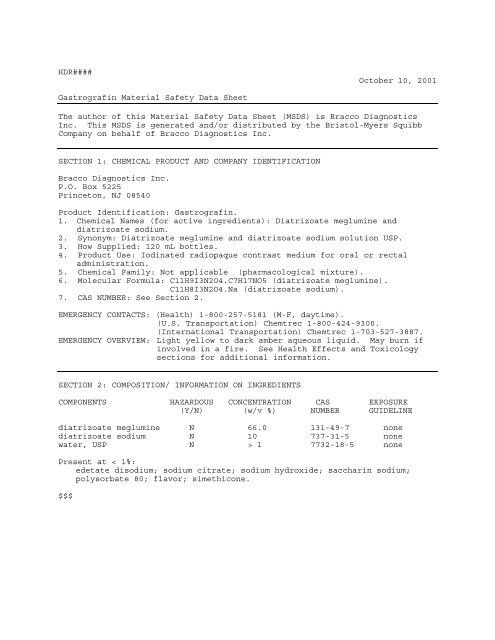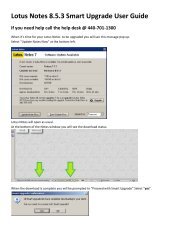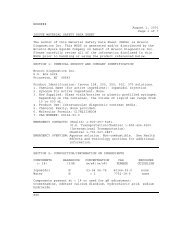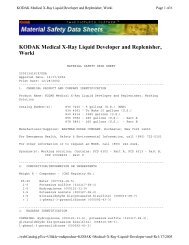HDR#### October 10, 2001 Gastrografin Material Safety Data Sheet ...
HDR#### October 10, 2001 Gastrografin Material Safety Data Sheet ...
HDR#### October 10, 2001 Gastrografin Material Safety Data Sheet ...
Create successful ePaper yourself
Turn your PDF publications into a flip-book with our unique Google optimized e-Paper software.
<strong>HDR####</strong><br />
<strong>Gastrografin</strong> <strong>Material</strong> <strong>Safety</strong> <strong>Data</strong> <strong>Sheet</strong><br />
<strong>October</strong> <strong>10</strong>, <strong>2001</strong><br />
The author of this <strong>Material</strong> <strong>Safety</strong> <strong>Data</strong> <strong>Sheet</strong> (MSDS) is Bracco Diagnostics<br />
Inc. This MSDS is generated and/or distributed by the Bristol-Myers Squibb<br />
Company on behalf of Bracco Diagnostics Inc.<br />
SECTION 1: CHEMICAL PRODUCT AND COMPANY IDENTIFICATION<br />
Bracco Diagnostics Inc.<br />
P.O. Box 5225<br />
Princeton, NJ 08540<br />
Product Identification: <strong>Gastrografin</strong>.<br />
1. Chemical Names (for active ingredients): Diatrizoate meglumine and<br />
diatrizoate sodium.<br />
2. Synonym: Diatrizoate meglumine and diatrizoate sodium solution USP.<br />
3. How Supplied: 120 mL bottles.<br />
4. Product Use: Iodinated radiopaque contrast medium for oral or rectal<br />
administration.<br />
5. Chemical Family: Not applicable (pharmacological mixture).<br />
6. Molecular Formula: C11H9I3N2O4.C7H17NO5 (diatrizoate meglumine).<br />
C11H8I3N2O4.Na (diatrizoate sodium).<br />
7. CAS NUMBER: See Section 2.<br />
EMERGENCY CONTACTS: (Health) 1-800-257-5181 (M-F, daytime).<br />
(U.S. Transportation) Chemtrec 1-800-424-9300.<br />
(International Transportation) Chemtrec 1-703-527-3887.<br />
EMERGENCY OVERVIEW: Light yellow to dark amber aqueous liquid. May burn if<br />
involved in a fire. See Health Effects and Toxicology<br />
sections for additional information.<br />
SECTION 2: COMPOSITION/ INFORMATION ON INGREDIENTS<br />
COMPONENTS HAZARDOUS CONCENTRATION CAS EXPOSURE<br />
(Y/N) (w/v %) NUMBER GUIDELINE<br />
diatrizoate meglumine N 66.0 131-49-7 none<br />
diatrizoate sodium N <strong>10</strong> 737-31-5 none<br />
water, USP N > 1 7732-18-5 none<br />
Present at < 1%:<br />
edetate disodium; sodium citrate; sodium hydroxide; saccharin sodium;<br />
polysorbate 80; flavor; simethicone.<br />
$$$
<strong>Gastrografin</strong> <strong>Material</strong> <strong>Safety</strong> <strong>Data</strong> <strong>Sheet</strong> (continued)<br />
SECTION 3: HEALTH HAZARDS IDENTIFICATION<br />
Page 2 of 6<br />
EFFECTS OF OVEREXPOSURE<br />
Routes of Entry:<br />
1. Inhalation: Under normal conditions exposure to this material by<br />
inhalation would not be expected to occur. However, in a situation<br />
where the liquid would be aerosolized, there may be potential for<br />
inhalation. The extent of systemic absorption of the material, if<br />
inhalation were to occur, is unknown.<br />
2. Skin contact: Exposure may occur via skin contact if gloves and<br />
protective clothing are not worn. The extent of systemic absorption of<br />
the material after skin contact is not known.<br />
3. Ingestion: Ingestion of large quantities of this material in an<br />
occupational setting would not be expected to occur. Ingestion of<br />
trace amounts of the material might occur if material contacts hands<br />
and hands are not washed prior to eating, drinking, or smoking.<br />
Diatrizoate meglumine and diatrizoate sodium are very poorly absorbed<br />
from the gastrointestinal tract.<br />
$$$<br />
Acute<br />
1. Ingestion: Inadvertent ingestion of trace amounts of this liquid would<br />
not be expected to result in symptoms. At therapeutic doses, most<br />
adverse effects associated with ingestion of this formulation are mild<br />
and transitory. However, nausea, vomiting and/or diarrhea, urticaria<br />
with erythema, hypoxia, acute dyspnea, tachyarrhythmia, and<br />
anaphylaxis have occurred following ingestion of the contrast medium,<br />
particularly after the administration of high concentrations or large<br />
volumes of solution. Electrolyte disturbances may also occur. Severe<br />
changes in serum osmolarity and electrolyte concentrations may produce<br />
shock-like states. Cases of hyperthyroidism have been reported with<br />
the use of iodine-containing oral contrast media.<br />
2. Inhalation: There is no information concerning the potential of this<br />
material to produce symptoms after inhalation of small amounts of<br />
aerosol. In general, inhalation of large amounts of liquid may result<br />
in pneumonia or pulmonary edema.<br />
3. Skin Contact:<br />
a. Toxic: Skin contact with small quantities of material for short<br />
periods is not expected to produce symptoms.<br />
b. Irritation: The irritant potential of this material of its<br />
components has not been evaluated.<br />
c. Sensitization: The potential of this material to act as a<br />
sensitizer (allergen) has not been evaluated.<br />
4. Eye Contact: <strong>Material</strong> has not been tested for eye irritation<br />
potential. In the absence of this information, the material should be<br />
handled as a potential eye irritant.<br />
Chronic<br />
<strong>Gastrografin</strong> is not intended for chronic use and there is no information<br />
on the possible adverse effects associated with chronic exposure. Chronic<br />
oral exposure may produce the same range of adverse effects associated<br />
with acute ingestion (see above).
<strong>Gastrografin</strong> <strong>Material</strong> <strong>Safety</strong> <strong>Data</strong> <strong>Sheet</strong> (continued)<br />
Exposure Guideline Summary: None.<br />
Page 3 of 6<br />
Carcinogen Lists IARC: Yes NTP: Yes OSHA: No<br />
Saccharin is listed by IARC as a Class 2B carcinogen (inadequate evidence<br />
for carcinogenicity to humans). This product contains 0.3 wt % saccharin<br />
sodium, which is considered a possible carcinogen based on development of<br />
bladder tumors in rodents that ingested very high doses for prolonged<br />
periods.<br />
Target Organs: No specific target organs identified.<br />
Medical Conditions Aggravated by Exposure: Therapeutic or excessive doses may<br />
aggravate gastrointestinal disorders, electrolyte disturbances, allergies to<br />
iodine, hyperthyroidism and euthyroid goiter.<br />
Medical Surveillance Recommendation: None.<br />
SECTION 4: FIRST AID MEASURES<br />
1. Ingestion: Seek medical attention immediately. Vomiting may be induced if<br />
person is conscious and not experiencing convulsions. Never give anything<br />
by mouth to an unconscious person.<br />
2. Inhalation: Remove exposed person to fresh air. If person is not<br />
breathing give artificial respiration. If breathing is difficult<br />
administer oxygen. Get medical attention.<br />
3. Skin Contact: Remove contaminated clothing. Wash skin with plenty of water<br />
for 5 minutes. Get medical attention if irritation (redness, itching or<br />
swelling) develops or persists.<br />
4. Eye Contact: Hold eyelids apart and flush with plenty of water for 5<br />
minutes. Get medical attention.<br />
5. Note to physicians: None.<br />
SECTION 5: FIRE FIGHTING MEASURES<br />
1. Flash point: Not determined.<br />
2. Auto-ignition Temperature: Not determined.<br />
3. Flammability limits<br />
a. LEL: Not determined.<br />
b. UEL: Not determined.<br />
4. Combustibility of Dusts: Not applicable.<br />
5. Extinguishing Media: Use dry chemical, carbon dioxide (CO2), or<br />
"alcohol" foam.<br />
6. Fire-fighting Instructions: Firefighters should wear self-contained<br />
breathing apparatus (SCBA), flame and chemical resistant clothing, boots<br />
and gloves. Evacuate personnel to upwind direction, remove unneeded<br />
material. Cool container(s) with water from maximum distance. Fight fire<br />
from a maximum distance or use an unmanned monitor. Move container from<br />
fire area if you can do it without risk.<br />
7. Hazardous Combustion Products: carbon monoxide, carbon dioxide, hydrogen<br />
iodide, iodine (reddish-brown gas), nitrogen oxides.<br />
8. Unusual Hazards: None known.<br />
$$$
<strong>Gastrografin</strong> <strong>Material</strong> <strong>Safety</strong> <strong>Data</strong> <strong>Sheet</strong> (continued)<br />
SECTION 6: ACCIDENTAL RELEASE MEASURES<br />
Page 4 of 6<br />
Spill/Clean-up: Absorb spill with inert material (e.g. sand, vermiculite or<br />
other non-combustible absorbent materials) and place into a closed container<br />
for reclamation or disposal. Flush residual spill area with water to process<br />
sewer if allowable under national, state, or local permits and regulations.<br />
SECTION 7: HANDLING AND STORAGE<br />
1. Handling Precautions: No special requirements.<br />
2. Container Requirements: Store in the container provided.<br />
3. Storage Conditions: Store at room temperature (20-25 degrees C). Avoid<br />
excessive heat. Protect from light.<br />
SECTION 8: EXPOSURE CONTROLS & PERSONAL PROTECTION<br />
1. Ventilation Requirements: None beyond good room ventilation normally<br />
required; local exhaust ventilation is recommended if significant dust<br />
concentrations are generated.<br />
2. Respiratory Protection: When engineering controls are not sufficient to<br />
control exposure, wear NIOSH approved respiratory protection appropriate<br />
for exposure potential; self-contained breathing apparatus should be<br />
available for emergency use.<br />
3. Eye Protection: Wear safety glasses (ANSI Z87.1).<br />
4. Protective Gloves: Wear impervious gloves (i.e., latex, latex/nitrile, or<br />
nitrile) if the potential exists for dermal contact.<br />
5. Special Clothing: Wear protective coveralls, whenever the potential for<br />
splashing or spraying liquids exists.<br />
6. Hygiene: Wash hands after handling compound and before eating, smoking,<br />
using lavatory, and at the end of the day.<br />
SECTION 9: PHYSICAL AND CHEMICAL PROPERTIES<br />
1. Appearance/Physical State/Color: 120 mL bottles containing light yellow to<br />
dark amber aqueous liquid.<br />
2. Boiling point: Not available.<br />
3. Evaporation rate: Not available.<br />
4. Flash point: Not available.<br />
5. Freezing point: Not available.<br />
6. Melting point: Not available.<br />
7. Octanol/water partition coefficient: Not available.<br />
8. Odor (threshold): Lemon.<br />
9. pH: 6.0 - 7.6.<br />
<strong>10</strong>. Solubility in water: Miscible.<br />
11. Specific gravity: 1.08.<br />
12. Vapor density (Air = 1): Greater than 1, heavier than air.<br />
13. Vapor Pressure: Not available.<br />
14. Viscosity: Not available.<br />
$$$
<strong>Gastrografin</strong> <strong>Material</strong> <strong>Safety</strong> <strong>Data</strong> <strong>Sheet</strong> (continued)<br />
SECTION <strong>10</strong>: STABILITY AND REACTIVITY<br />
Page 5 of 6<br />
1. Stability: Stable under normal conditions.<br />
2. Incompatibilities: None known.<br />
3. Conditions of Reactivity: Not determined.<br />
4. Hazardous Decomposition Products: carbon monoxide, carbon dioxide, hydrogen<br />
iodide, iodine (reddish-brown gas), nitrogen oxides.<br />
5. Hazardous Polymerization: Will not occur.<br />
6. Explosion data relative to mechanical impact: Not available.<br />
7. Explosion data relative to static discharge: Not available.<br />
SECTION 11: TOXICOLOGICAL INFORMATION – for active ingredients<br />
1. RTECS NUMBER (U.S.):<br />
- LZ4315000 (diatrizoate meglumine)<br />
- DG6125000 (diatrizoate sodium)<br />
2. ACUTE<br />
a. LD50 (diatrizoate meglumine):<br />
- Acute iv LD50 (rat) = 14,565 mg/kg;<br />
- Acute iv LD50 (mouse) = 21,200 mg/kg.<br />
b. LD50 (diatrizoate sodium):<br />
- Acute iv LD50 (rat) = 11,400 mg/kg;<br />
- Acute iv LD50 (mouse) = 14,000 mg/kg;<br />
- Acute iv LD50 (dog) = 13,200 mg/kg;<br />
- Acute iv LD50 (cat) = 11,300 mg/kg;<br />
- Acute iv LD50 (rabbit) = 12,200 mg/kg;<br />
- Acute im LD50 (mouse) = 20,349 mg/kg.<br />
3. LC50: Not applicable, exists as a liquid at room temperature.<br />
4. Diatrizoate meglumine and diatrizoate sodium would be classified as<br />
essentially nontoxic after acute intravenous injection.<br />
5. CHRONIC<br />
a. Carcinogenicity: See Section 3.<br />
b. Mutagenicity: No information.<br />
c. Teratogenicity: When administered intravenously, diatrizoate salts cross<br />
the placenta and are evenly distributed in fetal tissues. No<br />
teratogenic effects attributable to diatrizoate meglumine or diatrizoate<br />
sodium have been observed in teratology studies performed in animals.<br />
There are, however, no adequate and well-controlled studies in pregnant<br />
women.<br />
d. Reproductive Effects: It is not known whether <strong>Gastrografin</strong> can affect<br />
reproductive capacity. Diatrizoate meglumine is excreted in human<br />
breast milk following intravascular exposure.<br />
6. Toxicological synergistic products: None known.<br />
SECTION 12: ECOLOGICAL INFORMATION<br />
1. Ecotoxicological Information: No information<br />
2. Chemical Fate Information: No information.<br />
$$$
<strong>Gastrografin</strong> <strong>Material</strong> <strong>Safety</strong> <strong>Data</strong> <strong>Sheet</strong> (continued)<br />
SECTION 13: DISPOSAL CONSIDERATIONS<br />
Page 6 of 6<br />
Disposal: Dispose of in accordance with national, state, local and applicable<br />
country regulations.<br />
SECTION 14: TRANSPORT INFORMATION<br />
1. DOMESTIC<br />
a. Hazard Class (UN NUMBER): Not D.O.T. regulated.<br />
b. Proper shipping name: Not applicable.<br />
c. Label requirements: Not applicable.<br />
d. Placard requirements: Not applicable.<br />
e. Limited Quantity Exemption: Not applicable.<br />
2. INTERNATIONAL<br />
a. Hazard Class (UN NUMBER or PIN NUMBER): Not regulated.<br />
b. Proper shipping name: Not applicable.<br />
c. Label requirements: Not applicable.<br />
d. Placard requirements: Not applicable.<br />
e. Limited Quantity Exemption: Not applicable.<br />
SECTION 15: REGULATORY/STATUTORY INFORMATION – not meant to be all inclusive<br />
1. U.S. Federal: None noted.<br />
2. International: None noted.<br />
3. EC Labeling: None noted.<br />
SECTION 16: OTHER INFORMATION<br />
<strong>October</strong> <strong>10</strong>, <strong>2001</strong>: New MSDS for <strong>Gastrografin</strong> was developed, and supercedes the<br />
previous MSDS.<br />
Persons allergic to diatrizoate salts, iodides, or other components of this<br />
formulation should avoid contact to this substance.<br />
Diagnostic agents are intended for use under direction of a physician and/or<br />
under the conditions of use described on the label and in the product’s<br />
package insert. As a general precaution, personnel who handle drug substances<br />
should avoid contact (ingestion, inhalation, skin and eye contact) with these<br />
substances.<br />
This material safety data sheet is intended for use by personnel who handle<br />
this material as part of their job responsibilities. It does not address the<br />
diagnostic use of this material. Information concerning the diagnostic use of<br />
this drug substance should be obtained from formulated product package inserts<br />
and other appropriate references.<br />
The information contained in this MSDS is believed to be accurate and<br />
represents the best information available at the time of preparation.<br />
However, we make no warranty, express or implied, with respect to such<br />
information, and we assume no liability from its use.<br />
$$$





